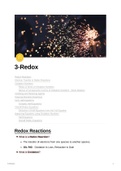🪙
3-Redox
Redox Reactions
Electron Transfer in Redox Reactions
Oxidation Numbers
Redox in terms of Oxidation Numbers
Names of Compounds in terms of Oxidation Numbers - Stock Notation
Oxidising and Reducing Agents
Disproportionation Reactions
Ionic Half-Equations
Complex Half-Equations
Overall Redox Equations
Deduction of Half-Equations from the Full Equation
Balancing Equations using Oxidation Numbers
Half-Equations
Overall Redox Equations
Redox Reactions
What is a Redox Reaction?
The transfer of electrons from one species to another species.
OIL RIG - Oxidation Is Loss, Reduction Is Gain
What is Oxidation?
3-Redox 1
, The loss of elections from a species; addition of oxygen; removal of hydrogen.
What is Reduction?
The gain of electrons by a species; removal of oxygen; addition of hydrogen.
Examples of Redox Reactions:
Burning of Fuels
Rusting of Iron
Bleaching of Dyes
Oxidation or reduction cannot take place on their own.
One substance is oxidised and another substance is reduced - redox.
Electron Transfer in Redox Reactions
When 1 substance is reduced by gaining electrons, the electrons have been
supplied by another species, which lost them, becoming oxidised.
2Br− + Cl2 → Br2 + 2Cl−
Bromide ions are oxidised to bromine.
Chlorine is reduced to chloride ions.
Oxidation Numbers
What is an Oxidation Number?
The oxidation number (oxidation state) of an element is the formal charge the
atom would have if the compound were purely ionic, with all the bonding
electrons belonging to the more electronegative element.
Not all reactions are oxidation reactions:
These reactions do not involve changes in oxidation number:
Acid-base reactions - a hydrogen ion is transferred from one species to
another.
Precipitation reactions - a solid precipitate is formed from the ions in 2
solutions attracting one another and reacting together.
3-Redox 2
, Rules for Assigning Oxidation Numbers:
1. Elements always have an oxidation number of 0.
2. The sum of the oxidation numbers in a compound is always 0.
3. The more electronegative element will have the more negative oxidation
number.
4. Fluorine always has an oxidation number of -1 in its compounds.
5. Oxygen usually has an oxidation number of -2, except in its compounds with
fluorine. In peroxides (H2 O2 ) = -1. In superoxides (KO2 ) = -1/2.
6. Hydrogen usually has an oxidation number of +1 in its compounds, except
for hydrides (KH) = -1.
7. The oxidation number of an element in a monatomic ion is the charge on
that ion. E.g. Cu2+ = +2.
8. The total charge on any polyatomic ion = the sum of the oxidation
numbers. E.g. NO3 − - N = +5, O = -2.
9. Group 1 = +1
10. Group 2 = +2
Element Oxidation Number
Li, Na, K +1
Mg, Ca, Sr, Ba +2
Al +3
N (except in some oxides) -3, +3, +5
O (except in peroxides and superoxides and compounds with
-2
fluorine)
-2, +1, +2, +2.5, +4,
S
+6
F -1
Cl, Br, I -1, +1, +3, +5, +7
Example - SO2 :
ON of S + 2x the ON of O = 0.
ON of O = -2
3-Redox 3
, -2 x 2 = -4
ON of S = +4
Example - MnO4 2− :
z + (4 x -2) = -2
z = -2 + 8 = +6
ON of Mg = +6
Redox in terms of Oxidation Numbers
2H2 S (g) + SO2 (g) → 3S (s) + 2H2 O (l)
H2 S has been oxidised (loss of hydrogen).
SO2 has been reduced (loss of oxygen).
The oxidation number of sulfur in H2 S is -2, in SO2 is +4 and in S is 0.
The H2 S has been oxidised and the oxidation number of S in H2 S has increased
from -2 to 0.
The SO2 has been reduced and the oxidation number of sulfur has decreased
from +4 to 0.
Oxidation occurs when the oxidation number of an element
increases.
Reduction occurs when the oxidation number of an element
decreases.
Names of Compounds in terms of Oxidation Numbers
- Stock Notation
The names of compounds and ions that contain an element that can have more
than one oxidation number include the oxidation number.
Written as a roman numeral.
Manganese in the MnO4 − ion is in the +7 state - Manganate (VII)
FeCl3 - Iron (III) chloride
3-Redox 4





